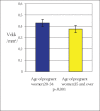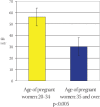Quantitative research of capillaries in terminal villi of mature placentae
- PMID: 20507296
- PMCID: PMC5509401
- DOI: 10.17305/bjbms.2010.2714
Quantitative research of capillaries in terminal villi of mature placentae
Abstract
Advanced maternal age is known to be a risk factor for placental dysfunctions. The most common obstetric complications among older women would be considered as follows: gestational diabetes; pre-eclampsia; placenta praevia; preterm premature rupture of membranes and the risk of preterm delivery. The aims of research were to determine the impact of maternal age on the structure of terminal villi. The study was conducted on 60 human placentae of term pregnancy divided into two groups: the control group (30 placentae in pregnant women of age between 20 and 34) and the experimental group (30 placentae in pregnant women of 35 years of age and older). Stereological methods were applied to determine the volume density, surface density, total volume and total capillary surface area in terminal villi of placenta. The mean value of volume density of capillaries in terminal villi of placentae in older pregnant women is: Vvkks = (0,376 +/- 0,033) mm(0), and the mean value of total volume is: Vkks = (157,047 +/- 25,022) cm(3). The mean value of surface density is: Svkks = (64,783 +/- 2,543) mm(-1), and the mean value of total surface area is: Skks = (29,959 +/- 7,873) m(2). Volume density of capillaries in terminal villi of placentae is significantly lower in older pregnant women (p<0.001) in comparison to the younger pregnant women. The total volume, surface density and total capillary surface area in terminal villi of placentae are also significantly lower in older pregnant women (p<0.005) in comparison to the younger pregnant women. Statistically significant lower values of volume density, total volume, surface density and total capillary surface area indicate that there is a decreased metabolic transfer between mother and foetus.
Figures








Similar articles
-
Stereological analysis of terminal villi of the placentas of pregnant woman with sideropenic anemia.Bosn J Basic Med Sci. 2014 Aug 18;14(3):139-43. doi: 10.17305/bjbms.2014.3.44. Bosn J Basic Med Sci. 2014. PMID: 25172972 Free PMC article.
-
[Stereologic analysis of chorionic villi and fibrinoids in the mature human placenta in pregnant women of various ages].Med Arh. 2002;56(5-6):255-8. Med Arh. 2002. PMID: 12693322 Croatian.
-
Stereological analysis of mature human placenta of pregnant women of different age.Bosn J Basic Med Sci. 2006 May;6(2):7-10. doi: 10.17305/bjbms.2006.3161. Bosn J Basic Med Sci. 2006. PMID: 16879105 Free PMC article.
-
Morphometric analysis of terminal villi and gross morphological changes in the placentae of term idiopathic intrauterine growth restriction.Tissue Cell. 2012 Aug;44(4):214-9. doi: 10.1016/j.tice.2012.03.006. Epub 2012 Apr 26. Tissue Cell. 2012. PMID: 22541804
-
Morphology and morphometric analysis of stromal capillaries in full term human placental villi of smoking mothers: an electron microscopic study.Clin Ter. 2011;162(4):301-5. Clin Ter. 2011. PMID: 21912816
Cited by
-
Canine Placenta Histological Findings and Microvascular Density: The Histological Basis of a Negative Neonatal Outcome?Animals (Basel). 2021 May 15;11(5):1418. doi: 10.3390/ani11051418. Animals (Basel). 2021. PMID: 34063427 Free PMC article.
-
Placental damages in preeclampsia - from ultrasound images to histopathological findings.J Med Life. 2015;8 Spec Issue(Spec Issue):62-5. J Med Life. 2015. PMID: 26366223 Free PMC article.
-
Association of Deep Learning-Derived Histologic Features of Placental Chorionic Villi with Maternal and Infant Characteristics in the New Hampshire Birth Cohort Study.medRxiv [Preprint]. 2025 Apr 23:2025.04.22.25325465. doi: 10.1101/2025.04.22.25325465. medRxiv. 2025. PMID: 40313259 Free PMC article. Preprint.
-
Allogenic Use of Human Placenta-Derived Stromal Cells as a Highly Active Subtype of Mesenchymal Stromal Cells for Cell-Based Therapies.Int J Mol Sci. 2021 May 18;22(10):5302. doi: 10.3390/ijms22105302. Int J Mol Sci. 2021. PMID: 34069909 Free PMC article. Review.
-
A morphometric and histological study of placental malaria shows significant changes to villous architecture in both Plasmodium falciparum and Plasmodium vivax infection.Malar J. 2014 Jan 4;13:4. doi: 10.1186/1475-2875-13-4. Malar J. 2014. PMID: 24386908 Free PMC article.
References
-
- Miletić T, Aberle N, Mikulandra F. Perinatal outcome of pregnancies in women aged 40 and over. Coll Antropol. 2002;26:251–258. - PubMed
-
- Ziadeh S, Yahaya A. Pregnancy outcome at age 40 and older. Arch Gynecol Obstet. 2001;265:30–33. - PubMed
-
- Abu-Heija AT, Jallad MF, Abukteish F. Maternal and perinatal outcome of pregnancies after the age of 45. J Obstet Gynaecol Res. 2000;26:27–30. - PubMed
-
- Li C, Ha Z, Teng Q. Clinical study on morphological characteristics of placenta on severe pregnancy induced hypertension. Zhonghua Fu Chen Ke Ze Zhi. 2000;35(11):651–653. - PubMed
-
- Sheiner E, Shoham-Vardi I, Hallak M. Placental abruption in term pregnancies: Clinical significance and obstetric risk factors. J. Matern. Fetal Neonatal Med. 2003;13:45–49. - PubMed

